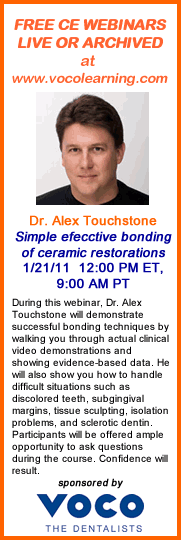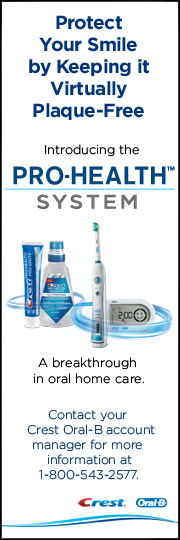 |

A member service that keeps you up-to-date on important new literature relevant to your practice.
 |
|
Welcome to JCDA Express for 2011!
In this first installment, JCDA has partnered with members of the graduate prosthodontics and periodontology programs at the University of Toronto faculty of dentistry, headed by Drs Asbjørn Jokstad and Jim Lai respectively. Under the guidance of Dr. Jokstad, a JCDA editorial consultant, these residents provide their critical appraisal of recent articles of interest in the prosthodontics and periodontology literature.
I invite you to read a brief message from Dr. Jokstad, in which he explains the genesis, format and rationale of the department’s literature review seminars.
As the year unfolds, JCDA will be exploring similar partnerships with other faculties and organizations—all in an effort to bring Canadian dentists the latest clinical and scientific material relevant to your practice.
JCDA would like to gratefully acknowledge the publishers of the selected articles, who have granted free access to the full-text papers until February 19, 2011. Follow the links in the Notes and News sidebar to discover more about these publications.
Yours sincerely,
Dr. John P. O'Keefe
Editor-in-chief
jokeefe@cda-adc.ca
|
|



The following 4 articles were edited and critically appraised by Dr. Asbjørn Jokstad and the residents of the University of Toronto graduate prosthodontics program.
 |
|
|

Dr. Babak Shokati, a member of the University of Toronto graduate prosthodontics program, selected:
Simonis P, Dufour T, Tenenbaum H. Long-term implant survival and success: a 10-16-year follow-up of non-submerged dental implants. Clin Oral Implants Res. 2010;21(7):772-77.
Full-text access to this article has expired.
What is the main clinical question addressed in the paper?
How likely is it that a patient with a partially dentate jaw restored with implant-retained fixed prostheses will experience technical and biological complications up to 16 years after treatment?
What is the current clinical “state of practice” or “state of understanding”?
Few studies have reported on the survival and success rate of prostheses supported by implants with a long-term range of up to 16 years follow-up.
Why is it important for the clinical question to be answered?
Patients often ask about the long-term prognosis of implant survival and prostheses success. There is a need for studies that can answer this question through long-term follow-up periods.
What is the main conclusion of the paper?
The cumulative success rate of implant-retained fixed prostheses was nearly 52%, up to a 16-year follow-up period. However, 93% of patients reported that they would have the same treatment again, if required.
What is your assessment of the quality of the paper and the underlying evidence?
This is a well-written article that has clear definitions of success and survival rates. It is one of the few papers with a long-term (10- to 16-year) follow-up period on implants. However, its shortcomings include that it is a retrospective case series study with no ethics approval, it had a high number of dropouts, and some categories had small sample sizes. Furthermore, no data were provided on the quality of prostheses and the opposing dentition.
What should a clinician take away from the study findings, in terms of potential impact on clinical practice?
A low 52% cumulative success rate after 16 years of observation represents a large amount of chair time required to manage the technical and biological complications following the insertion of implant-supported fixed prostheses.
|
|
 |

Dr. Mohammed Zahran, a member of the University of Toronto graduate prosthodontics program, selected:
Atieh MA, Atieh AH, Payne AG, Duncan WJ. Immediate loading with single implant crowns: a systematic review and meta-analysis. Int J Prosthodont. 2009;22(4):378-387.
Full-text access to this article has expired.
What is the main clinical question addressed in the paper?
Will a patient in need of a single implant in the anterior esthetic zone benefit from immediate loading or conventional loading, in terms of implant success and survival?
What is the current clinical “state of practice” or “state of understanding”?
Most of the available evidence supports the use of conventional loading protocol versus immediate loading.
Why is it important for the clinical question to be answered?
With an increase in the number of publications reporting outcomes of immediate loading of single implant crowns, it is beneficial to review the available evidence in a systematic manner.
What is the main conclusion of the paper?
This study shows that better outcomes are currently achieved using conventional loading of single implants with crowns. This is in comparison to immediate loading, which has a higher risk of failure.
What is your assessment of the quality of the paper and the underlying evidence?
This systematic review is well designed and factors in both controlled clinical trials and randomized controlled trials. It has high internal validity, despite that fact that non-English studies and outcomes related to satisfaction with esthetics were excluded. The articles included in the systematic review suffer from low sample size and short follow-up periods.
What should a clinician take away from the study findings, in terms of potential impact on clinical practice?
Clinicians should exercise caution with the immediate loading of implants with crowns as a standard of care for single tooth replacement.
|
|
 |
|
|

Dr. Mark Lin, a member of the University of Toronto graduate prosthodontics program, selected:
Etman MK, Woolford MJ. Three-year clinical evaluation of two ceramic crown systems: a preliminary study.J Prosthet Dent. 2010;103(2):80-90.
Full-text access to this article has expired.
What is the main clinical question addressed in the paper?
Does a patient in need of a crown on a premolar or molar tooth benefit from the clinical performance of castable glass ceramic and alumina coping crowns compared to metal ceramic crowns?
What is the current clinical “state of practice” or “state of understanding”?
The current standard of practice is to use metal ceramic crowns instead of all-ceramic due to the fracture susceptibility of all-ceramic restorations, especially on the posterior teeth.
Why is it important for the clinical question to be answered?
Little is known about the clinical performance of new all-ceramic systems when used for posterior crown fabrication. It is crucial to have long-term data from randomized controlled trials (RCTs) on these systems before their use in the posterior region can be generalized.
What is the main conclusion of the paper?
In this RCT, the clinical performance of the 3 crown systems (castable glass ceramic, alumina coping, metal ceramic) was comparable. The castable ceramic crowns showed better wear resistance than those with an alumina coping, according to modified United States Public Health Services criteria.
What is your assessment of the quality of the paper and the underlying evidence?
This is one of the few well-designed RCTs with a reasonable sample size that evaluates the outcomes of all-ceramic crowns compared to metal ceramic crowns. It would be beneficial to have a longer follow up (e.g. 5–7 years as opposed to 3 years) of the same cohort in the future.
What should a clinician take away from the study findings, in terms of potential impact on clinical practice?
Castable glass ceramic crowns are a promising prosthodontic alternative in the premolar and molar regions. However, they should be used selectively, not routinely, until long-term clinical studies with good success rates are available.
|
|
 |
|
|

Dr. Joseph Fava, a member of the University of Toronto graduate prosthodontics program, selected:
Teughels W, Merheb J, Quirynen M. Critical horizontal dimensions of interproximal and buccal bone around implants for optimal aesthetic outcomes: a systematic review. Clin Oral Implants Res. 2009;20(Suppl 4):134-45.
Full-text access to this article has expired.
What is the main clinical question addressed in the paper?
Are there any critical horizontal interproximal and buccal bone dimensions around surgically placed implants associated with optimal esthetic outcomes?
What is the current clinical “state of practice” or “state of understanding”?
It has been suggested that the buccal bone thickness should be at least 2 mm. In relation to mesiodistal dimensions, it has also been suggested that the distance between a tooth and an implant should not be less than 1.5 mm. And between 2 implants, the distance should not be less than 3 mm.
Why is it important for the clinical question to be answered?
Scientifically based surgical parameters may improve the likelihood of an optimal esthetic result when restoring edentulous spaces with dental implant-supported prostheses.
What is the main conclusion of the paper?
The current available information provides no strict guidelines for the critical dimensions examined in this study. A 3-mm interproximal distance between implants seems to increase the likelihood of adequate papillary fill. In the bucco-oral direction, further research needs to be undertaken before determining a threshold for buccal bone thickness.
What is your assessment of the quality of the paper and the underlying evidence?
This is a good quality systematic review. However, further prospective studies are required before any predictable guidelines can be established.
What should a clinician take away from the study findings, in terms of potential impact on clinical practice?
Clinicians should follow existing guidelines for horizontal dimensions when placing implants until further evidence either validates or invalidates our current state of understanding.
|
|
 |
|
|
Message from Dr. Asbjørn Jokstad

The volume of new research literature is overwhelming. Colleagues apply different strategies to cope with this information overflow. At the U of T prosthodontics residency program, we’ve established a concept of collective responsibility for updating each other on the most groundbreaking research within the discipline.
During a lively 90-minute seminar held each week, 2 prosthodontics and 2 periodontology residents present and defend what they consider the best articles among 25 selected specialty publications. In a competitive yet friendly atmosphere, the articles are critically appraised and debated among the group.
The residents judge the articles on originality, novelty of analysis and clarity of presentation. They cover all aspects related to etiology, diagnosis, therapy, prevention and prognosis. Some of the selected articles present important new findings that dentists or the dental team could consider implementing into daily practice.
Working in consultation with JCDA, we will strive to bring Canadian dentists what we consider the most significant and relevant developments for practice within the field of prosthodontics as well as the prosthodontics–periodontology interface.
Asbjørn Jokstad, DDS, PhD
Head of prosthodontics, faculty of dentistry,
University of Toronto
|
|
|
|
|

JCDA is the authoritative written voice of the Canadian Dental Association, providing dialogue between the national association and the dental community. It is dedicated to publishing worthy scientific and clinical articles and informing dentists of issues significant to the profession.

|

|

|
NOTES AND NEWS
Check out the publications featured in this issue
Clinical Oral Implants Research
(publisher: Wiley-Blackwell)
International Journal of Prosthodontics
(publisher: Quintessence Publishing)
Journal of Prosthetic Dentistry
(publisher: Elsevier)
Learn more about the University of Toronto prosthodontics and periodontology programs.
2011 CDA convention: See you in Halifax in August
The next CDA convention will take place in Halifax, August 4-6, 2011. The theme of the convention is “Navigating Tomorrow—New Visions, Historical Foundations.” Registration, hotel and social program details have now been added to cdaconvention2011.com.
Canadian Conference on Physician Leadership: Effecting Change Through Influence.
Vancouver, BC
May 13-14, 2011
The Canadian Medical Association and Canadian Society of Physician Executives are hosting a 2-day conference and workshop. Dentists can attend to gain insight into achieving behavioural and system change. Visit www.2011leadership.ca for program and registration details.
Flu season is back. Share your thoughts on CDA’s Pandemic Plan
CDA would like your feedback on CDA’s Pandemic Plan via a short questionnaire. Your responses will be anonymous and confidential and will help CDA prepare for future public health challenges.
Search the JCDA Classified Ads
Looking for employment? Want to sell your practice? Classified ads offer the most effective way to reach all dentists and students in Canada.
Spread the word
Help spread the word about JCDA Express by telling your colleagues about it and reminding them to send CDA their email address.
reception@cda-adc.ca
|
|
|

|
|

|

|
|





